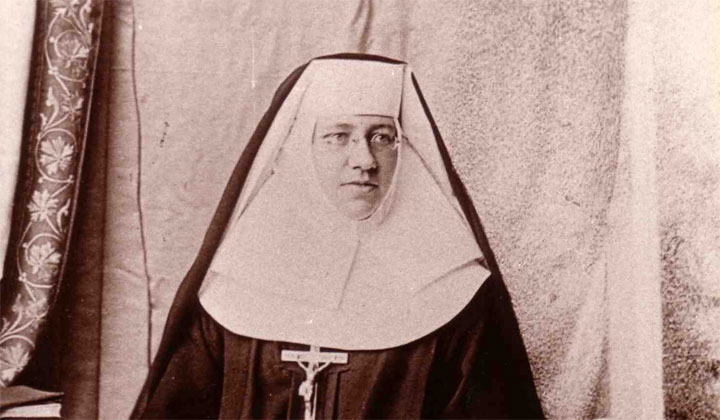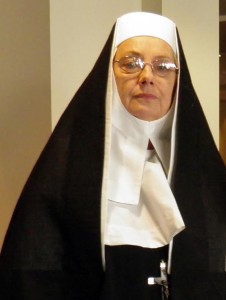
The Pope, Francis: The organizers of the largest Catholic event in the history of Philadelphia wanted to make sure that the participants from all over North America in the “World Meeting of Families Youth Congress” would have a chance to meet a saint, Mother Katharine Drexel—just a few days before they would actually meet Pope Francis.
The Saint, Mother Katharine Drexel: “The woman, the daughter, the founder and member of a religious order, and a philanthropist. . . . Her life span of 96 years (1858 to 1955) covered a remarkable period in history which included the entirety of the Civil War, the assassination of Abraham Lincoln, Red Cloud’s War and other major skirmishes with Native Americans out West, the implementation of the Jim Crow Laws and the Ku Klux Klan, the founding of the NAACP, and women’s suffrage” (American Historical Theatre).
“Often in my desire to work for others I find my hands tied, something hinders my charitable designs, some hostile influence renders me powerless. My prayers seem to avail nothing, my kind acts are rejected, I seem to do wrong things when I am trying to do my best. In such cases I must not grieve. I am only treading in my Master’s steps” (Sister Katharine Drexel).
The Writer, Rene Goodwin: The American Historical Theatre and the Four Freedoms Foundation commissioned Goodwin—Philadelphia playwright, actor, and singer—to write and perform a play about one of the few American saints. For almost 20 years, Goodwin has been creating a body of work titled “Women of Note”—theatrical monologues about the lives of 20th century iconic women, including Eleanor Roosevelt, Golda Meir, Dorothy Parker, and Jacqueline Bouvier Kennedy.

The Philadelphia playwright-actor sees herself “not [as] an historian or interpreter. I am an actor attempting to present the humanity of these female icons, complete with all the human frailties, challenges, weaknesses and strengths they possess. All of these women have had some sort of childhood challenges.”
The hierarchy of the Catholic Church: Given the Vatican’s history of censorship (the Index Librorum Prohibitorum, the List of Prohibited Books), especially the fact that “Catholic canon law still recommends that works concerning . . . church history, and any writings which specially concern religion or morals, be submitted to the judgment of the local ordinary,” I asked whether anyone in the hierarchy of the Catholic Church had told Goodwin what to write or had given her an outline of the play. She made it quite clear that no one had handed her a partial script or anything else. “Most of the time, I alone decide who I want to research and write about. I write from scratch, based on the research I do.”
Goodwin then clarified, “This one was different in that I was asked, commissioned, and contracted to write a piece on Mother Katharine Drexel specifically for the World Meeting of Families.” Because of the success of the first performance, “there is reason to expect that there is and will be interest in the piece beyond this special event. [However,] like all the pieces I create, [it] will change and grow as time goes on and the need arises.”
The Play,Sister Katharine Drexel: A richness of spirit (three excerpts):
- Native Americans: “In 1894, we [the Sisters of the Blessed Sacrament] went to Santa Fe to educate Pueblo boys and later girls. When we arrived, we found that there were no curtains on the windows and the bathroom was a ¼ mile from the building.”
- Slave descendants and exploitation of workers: “We then went on a trip to Virginia to open two more schools to educate boys and girls descended from slaves. The next group of sisters headed off to Arizona at the worst possible time. They traveled in the midst of a nationwide worker’s strike because George Mortimer Pullman, manufacturer of the Pullman car on trains, reduced the wages of workers but not the cost of housing they were forced to live in. [. . .] gunfire became a part of the strike. [. . .] When the train was finally able to finish its journey, the sisters were joined on the train by soldiers with fixed bayonets.”
- Civil War ends slavery but not bigotry: “My family supported President Lincoln’s policy of no slavery. The abuse and loss of freedom for slaves was abhorrent. My family knew this was wrong and not the way God’s children should be treated. The Civil War had put an end to slavery, but, unfortunately, not to bigotry.”
The Actor and the Audience, Goodwin and the World Meeting of Families: At the end of some shows, the actors, say Romeo and Juliet, stand at the exit with a box, collecting money for a theater arts related charity. Audience members often use those moments to thank the actors for a great performance, perhaps even sharing with them that they have seen them before, for example, as Tom and Laura in The Glass Menagerie. However, this religious, miracle-hungry audience in Philadelphia, a few days before the Pope’s arrival, ready to believe and pray, could not distinguish between Ms. Goodwin, the actor in nun’s clothing, and Mother Katharine, the Saint who had died in 1955.
Kim Hanley, the executive director of the American Historical Theatre, initiated and actively supported the development of the Mother Katharine piece and supplied the historically correct nun’s habit. The results shocked even the experienced Goodwin, whose physical resemblance to the saint is remarkable. Goodwin was both stunned and taken aback by the love and admiration that engulfed her as Mother Katharine at the World Meeting of Families:
“As actors, we find ourselves in an endless variety of situations and roles. Portraying roles like Mother Katharine on stage is one thing, but as I entered the area to deliver my program, I was responded to by a number of people as if I were the real thing. That was bad enough, but when a particular Bishop did it, I said that’s enough. I felt compelled to be truthful with him about my identity. After all, I am an actor, but by no means a Saint.”
I wonder what Jorge Mario Bergoglio, the Argentinian with Italian roots, feels when he gets treated as a holy man by many Catholics who revere him as a living saint like Saint Francis, Mother Theresa, and Mother Katharine. I wonder what it is that makes even non-religious Americans see Pope Francis as a world class superstar who performs on stages in Havana; Washington, DC; New York; and Philadelphia.
Maybe Shakespeare’s words, excerpted on a statue along the Ben Franklin Parkway where Pope Francis gave mass, had the answer to this conundrum:
“All the world’s a stage,
And all the men and women merely players;
They have their exits and their entrances,
And one man in his time plays many parts.”
To contact Rene Goodwin on her Mother Katharine program and that of other famous women, including her much talked about Golda production, visit gh-entertainment.com.

Great job! Keep expanding. Behind every great woman is a great man!Bob F